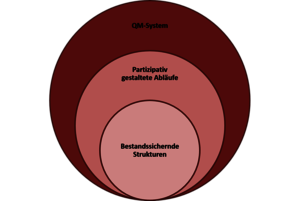- About the university
- Einfache Sprache
- Rector’s office
- Administration
- General Contact Information
- Student Affairs Office
- Library and Media Centre
- Faculty Management & Secretary's Offices
- Orchestra Management
- Event Management
- External Relations, Development and Quality Assurance
- Marketing and Communication
- Human Resources Management
- Accounting/Controlling
- IT Management
- Infrastructure/Facility Management
- Porters
- Quality management
- Sites
- Opening hours
- Vollpension at the MUK
- Cooperations
- MUK.youngstars
- Vacancies
- Press
- International relations
Internal quality assurance
Structures to secure the existence of the company
Pillars of the structures that secure the university's continued existence are formed by the type of company, ownership, the area of activity (Wien Holding, GmbH, private university) and the internal bodies and committees (University Council, Senate, Rectorate, StuFoKo, University Assembly, Faculty Conference, Task Force for Equal Treatment Issues) as well as the functions of individual responsible persons (Rector, Vice-Rector, Dean, department heads, heads of study programmes, coordinators, Director of Studies). The participation of the university's internal interest groups is completed by independent commissions and working groups. Admission to studies as well as the assessment of achievements are clearly regulated.
The guidelines, instructions, regulations and plans according to which MUK operates are set out in the following documents:
Statutes (including the following documents)
Study regulations
Examination regulations
Appointment regulations
Evaluation guidelines
Election rules
Development plan
Job advertisements
Bylaws
Quality and organization manual
Participatory processes
The structures of the MUK ensure controlled, guided and participatory processes. The MUK's organizational structure ensures that relevant decisions are made with the involvement of several levels and competencies.
The persons in charge (both committees and individuals in their functions) act in coordination with the structures and their integration. The tasks are regulated and are carried out jointly by spreading the responsibilities and co-designing the interest groups. All members of the university have a say and are integrated by being involved in various decision-making levels and by the composition of university committees and bodies.
At the MUK, decisions and guidelines for development and advancement are made in participatory processes. Decision-making processes of bodies and committees are usually accompanied by at least one other instance, the form of which is laid down in the statutes of the MUK.
The participatory design of the MUK is set out in the following documents:
Statutes (regulations on procedures and composition of committees, organs and working groups)
Documentation takes place via invitations, protocols
Quality Management System
The MUK QM system systematically supports the achievement of the demands and goals formulated in the mission statement as well as the guiding principles stated in the statutes with procedures and instruments for quality assurance and development. It thus contributes to the maintenance and further sharpening of the university profile and the self-image of a learning and teaching institution.
The MUK QM system uses intensive internal communication and analysis of relevant documents and data to check
the instruction of and compliance with processes
the application and implementation of quality assurance instruments
compliance with regulations and decisions
service-oriented instruments and tasks
The internal QM system determines the system and its potential for improvement by regularly reviewing selected processes, task areas, data and figures.
By means of protocols, bulletins, instructions, assessments, records in the performance database and on MUKonline, results and decisions, procedures and successes are documented.
The structure of the QM system is developed, checked and updated by the quality management. Following the Total Quality Management principle, the system is continuously improved with the involvement and co-responsibility of all employees.
The fulfilment of these tasks follows the quality assuring PDCA cycle.
PLAN Planning processes participatively
DO Processes through internal structures enable and secure
CHECK Review of processes (by organs, committees and responsible university members)
ACT Improve and systematize internal processes



